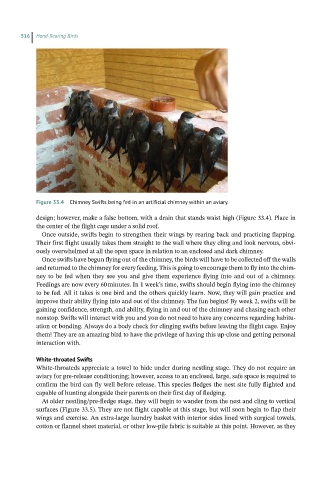Page 519 - Hand rearing birds second
P. 519
516 Hand-Rearing Birds
Figure 33.4 Chimney Swifts being fed in an artificial chimney within an aviary.
design; however, make a false bottom, with a drain that stands waist high (Figure 33.4). Place in
the center of the flight cage under a solid roof.
Once outside, swifts begin to strengthen their wings by rearing back and practicing flapping.
Their first flight usually takes them straight to the wall where they cling and look nervous, obvi-
ously overwhelmed at all the open space in relation to an enclosed and dark chimney.
Once swifts have begun flying out of the chimney, the birds will have to be collected off the walls
and returned to the chimney for every feeding. This is going to encourage them to fly into the chim-
ney to be fed when they see you and give them experience flying into and out of a chimney.
Feedings are now every 60 minutes. In 1 week’s time, swifts should begin flying into the chimney
to be fed. All it takes is one bird and the others quickly learn. Now, they will gain practice and
improve their ability flying into and out of the chimney. The fun begins! By week 2, swifts will be
gaining confidence, strength, and ability, flying in and out of the chimney and chasing each other
nonstop. Swifts will interact with you and you do not need to have any concerns regarding habitu-
ation or bonding. Always do a body check for clinging swifts before leaving the flight cage. Enjoy
them! They are an amazing bird to have the privilege of having this up-close and getting personal
interaction with.
White-throated Swifts
White-throateds appreciate a towel to hide under during nestling stage. They do not require an
aviary for pre-release conditioning; however, access to an enclosed, large, safe space is required to
confirm the bird can fly well before release. This species fledges the nest site fully flighted and
capable of hunting alongside their parents on their first day of fledging.
At older nestling/pre-fledge stage, they will begin to wander from the nest and cling to vertical
surfaces (Figure 33.5). They are not flight capable at this stage, but will soon begin to flap their
wings and exercise. An extra-large laundry basket with interior sides lined with surgical towels,
cotton or flannel sheet material, or other low-pile fabric is suitable at this point. However, as they

